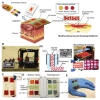Progress of Hydrogel Dressings with Wound Monitoring and Treatment Functions
- PMID: 37754375
- PMCID: PMC10528853
- DOI: 10.3390/gels9090694
Progress of Hydrogel Dressings with Wound Monitoring and Treatment Functions
Abstract
Hydrogels are widely used in wound dressings due to their moisturizing properties and biocompatibility. However, traditional hydrogel dressings cannot monitor wounds and provide accurate treatment. Recent advancements focus on hydrogel dressings with integrated monitoring and treatment functions, using sensors or intelligent materials to detect changes in the wound microenvironment. These dressings enable responsive treatment to promote wound healing. They can carry out responsive dynamic treatment in time to effectively promote wound healing. However, there is still a lack of comprehensive reviews of hydrogel wound dressings that incorporate both wound micro-environment monitoring and treatment functions. Therefore, this review categorizes hydrogel dressings according to wound types and examines their current status, progress, challenges, and future trends. It discusses various wound types, including infected wounds, burns, and diabetic and pressure ulcers, and explores the wound healing process. The review presents hydrogel dressings that monitor wound conditions and provide tailored treatment, such as pH-sensitive, temperature-sensitive, glucose-sensitive, pressure-sensitive, and nano-composite hydrogel dressings. Challenges include developing dressings that meet the standards of excellent biocompatibility, improving monitoring accuracy and sensitivity, and overcoming obstacles to production and commercialization. Furthermore, it provides the current status, progress, challenges, and future trends in this field, aiming to give a clear view of its past, present, and future.
Keywords: hydrogel; treatment; wound dressing; wound monitoring.
Conflict of interest statement
The authors declare no conflict of interest.
Figures
















References
Publication types
Grants and funding
LinkOut - more resources
Full Text Sources
Miscellaneous

